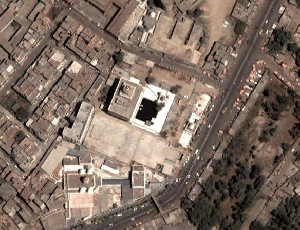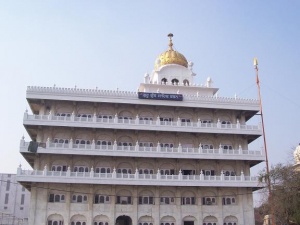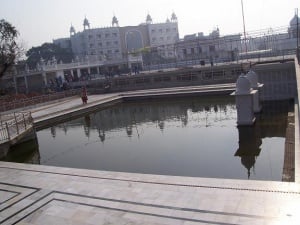Gurdwara Ramsar Sahib: Difference between revisions
Hari singh (talk | contribs) No edit summary |
Allenwalla (talk | contribs) m (restructured and condensed article deleting double sentences, facts and dates, ect. - please check and improve and make any corrections needed.) |
||
| Line 15: | Line 15: | ||
In this holy book, Guru Arjun Dev collected the hymns of first four Gurus, [[Guru Nanak]], [[Guru Angad]], [[Guru Amar Das]], [[Guru Ram Das]]. He also added his own compositions as well as selections from the writings of several [[Hindu]] and [[Muslim]] saints. The selection for the holy scripture was based on the main principle of [[Sikhism]]. In this unique holy book is preserved the purity of the scriptures, embodying, the philosophy of the Gurus for the perpetual guidance of Sikhism and other faiths. | In this holy book, Guru Arjun Dev collected the hymns of first four Gurus, [[Guru Nanak]], [[Guru Angad]], [[Guru Amar Das]], [[Guru Ram Das]]. He also added his own compositions as well as selections from the writings of several [[Hindu]] and [[Muslim]] saints. The selection for the holy scripture was based on the main principle of [[Sikhism]]. In this unique holy book is preserved the purity of the scriptures, embodying, the philosophy of the Gurus for the perpetual guidance of Sikhism and other faiths. | ||
[[Image:Ramsarsaab.JPG|thumb|left|300px|Sarovar Ramsar]] | [[Image:Ramsarsaab.JPG|thumb|left|300px|Sarovar Ramsar]] | ||
{{fa|31}} | |||
[[Image:Ramsarbuild.JPG|thumb|300px|Right|Gurdwara Ramsar Sahib Side View]] | |||
'''Gurdwara Ramsar''' stands alongside the Ramsar sarovar, the smallest of Amritsar's five holy sarovars. Located near Chativind Gate, on the south-eastern side of the walled city of Amritsar, the present Gurdwara Ramsar is a small marble-lined hall topped by a gilded, fluted lotus dome. It was built in 1855 at the site of the original shrine, where long before the present Gurdwara was constructed, [[Guru Arjun Dev]], the fifth Sikh Guru who was looking for a quiet spot away from the growing city of Amritsar, chose this site as the spot where the [[Guru Granth Sahib]] would take form. | |||
It was the year 1603, after the completion of the [[Harimandir Sahib]] in 1601, that the beloved Guru choose this once secluded, shady spot, about 1km away from the bustle of the town growing around the Harmandar Sahib, that the Guru set about collecting the hymns of the first four Gurus, [[Guru Nanak]], [[Guru Angad]], [[Guru Amar Das]] and [[Guru Ram Das]]. Although there was plenty of cooling shadetrees around and the spot provided the quiet that the Guru needed, the cooling breezes of the Amrit Sarovar were far away. To make the surroundings more agreeable, Guru ji had a small tank dug, which he named Ramsar after his father [[Guru Ram Das]]. He and his his scribe, [[Bhai Gurdas]] spent over a year at the site in semi-seclusion. To the teachings of the earlier Gurus, Guruji added his own compositions, as well as selections from the writings of several [[Hindu]] Sants and [[Muslim]] Pirs that shared the principles of [[Sikhism]]. | |||
After the completion of the Adi Granth (lit. First Book) in 1604 the Adi Granth was installed, with due honor and ceremony, in the [[Harimandir Sahib]]. Today the Adi Granth is known as the [[Guru Granth Sahib]]; the sacred Sikh scripture. The Guru Granth Sahib, which now spans 1430 pages, was installed by Guru Gobind Singh as the Eternal Guru of the Sikhs, shortly before his death. This unique holy book preserves the purity of the scriptures, embodying, the philosophy of the Gurus for the perpetual guidance of Sikhism, as well as other faiths. | |||
[[Image:Ramsar.gif|thumb|300px|right|Aerial View & map [http://wikimapia.org/#y=31613627&x=74881005&z=18&l=0&m=h Ramsar Sahib @ wikimapia.org] ]] | |||
This spot was also where Guru Arjan composed his famous [[Sukhmani]] (the "Psalm of Peace"). As this site marks the exact location of the Guru's labours and the formal beginning of the Sikh scripture, it is only natural that this place where the current, perpetual and honoured Sikh Guru, the [[Guru Granth Sahib]] was first created, is a site of special significance for all Sikhs. | |||
[[Image:Ramsarsaab.JPG|thumb|left|300px|Sarovar Ramsar]] | |||
==See also== | ==See also== | ||
* [[Harmandar sahib gurdwara complex]] | * [[Harmandar sahib gurdwara complex]] | ||
Revision as of 23:51, 15 January 2010
Alongside the Ramsar Gurdwara is situated the smallest of the five sarovars called Ramsar. This is the location where in 1603, Guru Arjun Dev, the fifth Sikh Guru spent over a year in semi-seclusion along with his scribe, Bhai Gurdas to compile the original holy Adi Granth, the sacred Sikh scripture. The sacred volume which now spans 1430 pages, was finally completed in 1604. It was then installed with due honor and ceremony in the Harimandir Sahib which lies to the north of this location.
Gurdwara Ramsar stands on the north-western bank of the Ramsar sarovar, near Chativind Gate, on the south-eastern side of the walled city. After the completion of the building of the Harimandir Sahib in 1601, Guru Arjan undertook the compilation of Adi Granth, the Holy Book, now revered as Guru Granth Sahib in 1603.

For this task, he chose a secluded site. The selected spot was then a shady nook, about 1km away from the bustle of the old town. To make the surroundings more agreeable, Guru ji had a small tank dug out which was then named Ramsar after his father, Guru Ram Das. It was at this newly contructed site that Guru Arjan composed his famous Sukhmani, the "Psalm of Peace", and with Bhai Gurdas as his scribe compiled the Adi Granth during the period 1603-04.
The present Gurdwara Ramsar is a small marble-lined hall topped by a gilded, fluted lotus dome and was built in 1855 at the site of the original shrine. Hence, this site marks the exact location of the Guru's labours and the formal beginning of the Sikh scripture. This was the place where the current, perpetual and honoured Sikh Guru, Guru Granth Sahib was first created. So, this site is of special significance for the Sikhs.
In this holy book, Guru Arjun Dev collected the hymns of first four Gurus, Guru Nanak, Guru Angad, Guru Amar Das, Guru Ram Das. He also added his own compositions as well as selections from the writings of several Hindu and Muslim saints. The selection for the holy scripture was based on the main principle of Sikhism. In this unique holy book is preserved the purity of the scriptures, embodying, the philosophy of the Gurus for the perpetual guidance of Sikhism and other faiths.
Gurdwara Ramsar stands alongside the Ramsar sarovar, the smallest of Amritsar's five holy sarovars. Located near Chativind Gate, on the south-eastern side of the walled city of Amritsar, the present Gurdwara Ramsar is a small marble-lined hall topped by a gilded, fluted lotus dome. It was built in 1855 at the site of the original shrine, where long before the present Gurdwara was constructed, Guru Arjun Dev, the fifth Sikh Guru who was looking for a quiet spot away from the growing city of Amritsar, chose this site as the spot where the Guru Granth Sahib would take form.
It was the year 1603, after the completion of the Harimandir Sahib in 1601, that the beloved Guru choose this once secluded, shady spot, about 1km away from the bustle of the town growing around the Harmandar Sahib, that the Guru set about collecting the hymns of the first four Gurus, Guru Nanak, Guru Angad, Guru Amar Das and Guru Ram Das. Although there was plenty of cooling shadetrees around and the spot provided the quiet that the Guru needed, the cooling breezes of the Amrit Sarovar were far away. To make the surroundings more agreeable, Guru ji had a small tank dug, which he named Ramsar after his father Guru Ram Das. He and his his scribe, Bhai Gurdas spent over a year at the site in semi-seclusion. To the teachings of the earlier Gurus, Guruji added his own compositions, as well as selections from the writings of several Hindu Sants and Muslim Pirs that shared the principles of Sikhism.
After the completion of the Adi Granth (lit. First Book) in 1604 the Adi Granth was installed, with due honor and ceremony, in the Harimandir Sahib. Today the Adi Granth is known as the Guru Granth Sahib; the sacred Sikh scripture. The Guru Granth Sahib, which now spans 1430 pages, was installed by Guru Gobind Singh as the Eternal Guru of the Sikhs, shortly before his death. This unique holy book preserves the purity of the scriptures, embodying, the philosophy of the Gurus for the perpetual guidance of Sikhism, as well as other faiths.

This spot was also where Guru Arjan composed his famous Sukhmani (the "Psalm of Peace"). As this site marks the exact location of the Guru's labours and the formal beginning of the Sikh scripture, it is only natural that this place where the current, perpetual and honoured Sikh Guru, the Guru Granth Sahib was first created, is a site of special significance for all Sikhs.
See also
- Harmandar sahib gurdwara complex
- Harmandar Sahib
- Guru Granth Sahib
- Guru Arjan
- Sukhmani sahib
- Jewel of peace
- Gurdwara Ramsar place where Guru Arjan composed Sukhmani sahib
- Bani
- Brahm Giani
External links
| Five Sarovars of Amritsar |
|
▝ Amritsar ▝ Kaulsar ▝ Santokhsar ▝ Bibeksar ▝ Ramsar ▝ |


